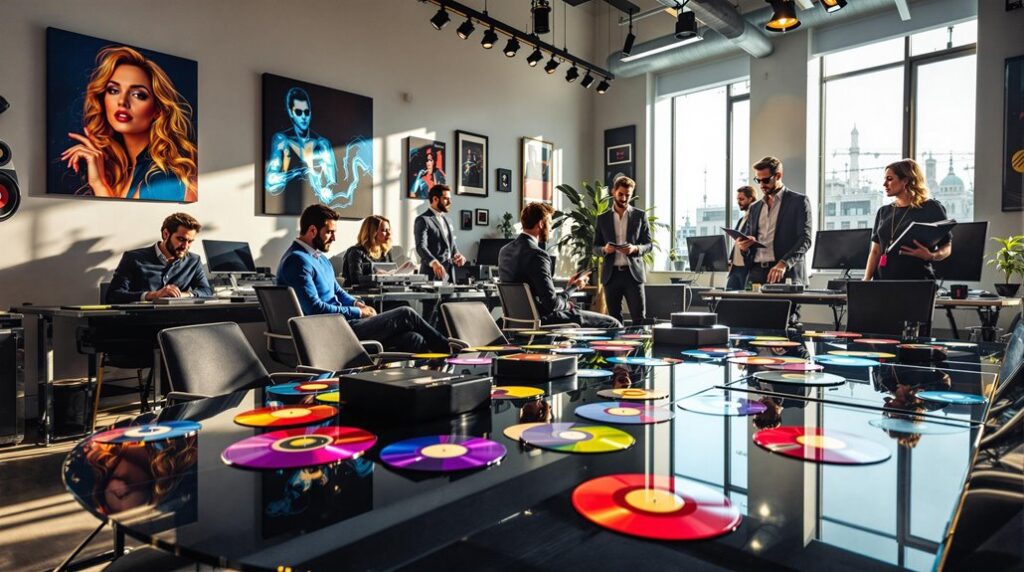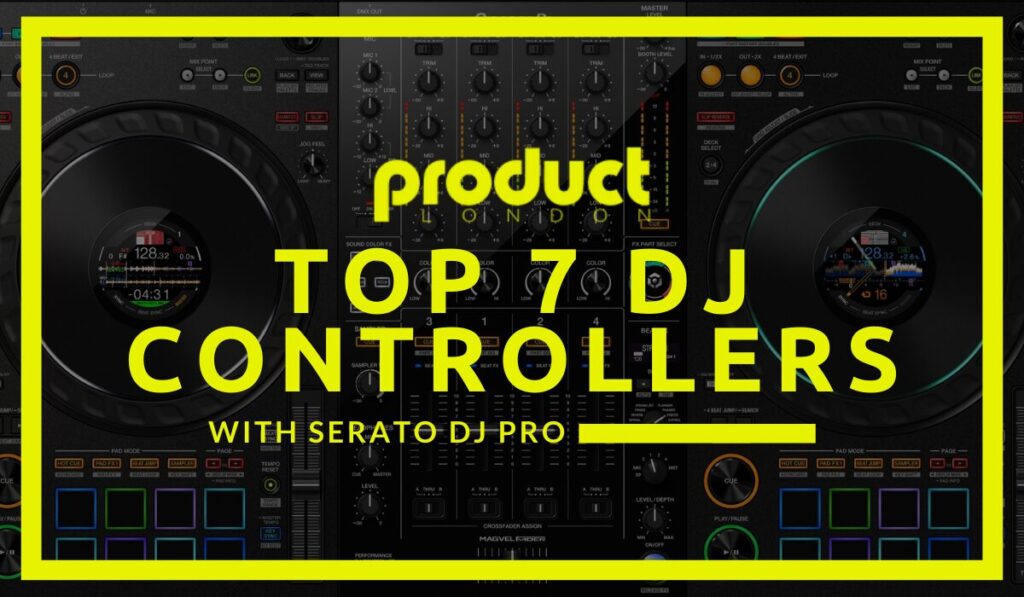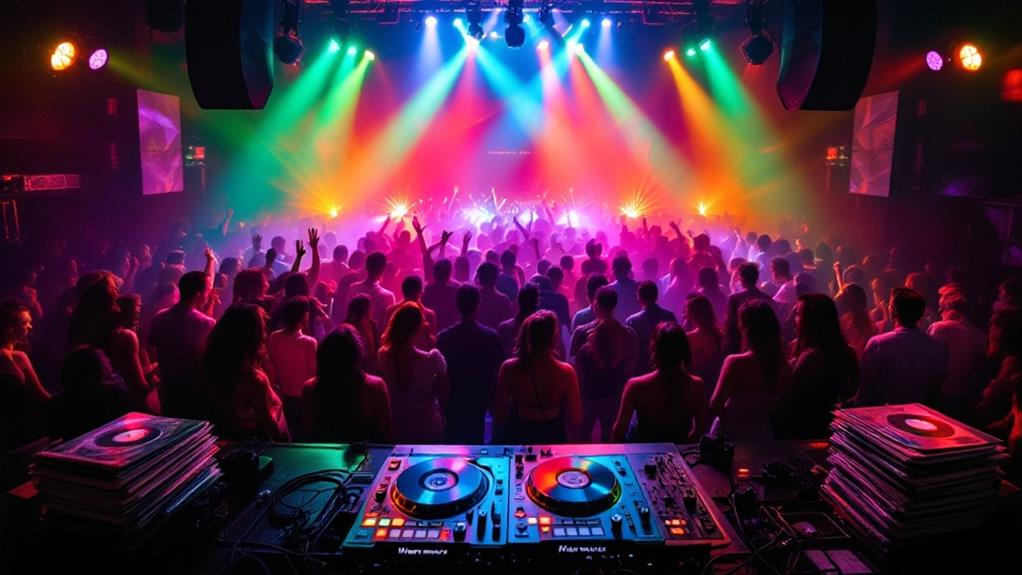A complete DJ setup necessitates three primary components: DJ controllers or mixers, audio sources, and sound output devices. DJ controllers amalgamate turntable and mixer functionalities with jog wheels and EQ controls, often pre-mapped to software like Serato for ease of use. Audio sources, including iconic Technics turntables or versatile CDJs, introduce varied sonic textures and dynamic performance flexibility. Sound output devices, such as monitor speakers and active PA speakers with built-in amplifiers, guarantee sound clarity during mixing and live shows. Together, these components form the backbone of any DJ performance, with each playing a pivotal role in creating seamless audio experiences.
Key Takeaways
- DJ controllers combine turntable and mixer functions, offering an intuitive interface for software control and seamless mixing.
- Mixers serve as central audio routing hubs, providing effects and multi-channel capabilities for complex audio manipulation.
- Diverse audio sources like turntables, CDJs, and laptops enhance performance flexibility and depth.
- Monitor and active PA speakers ensure precise sound playback and clarity during live performances.
- High-quality headphones are essential for cueing and maintaining precise timing with sound isolation.
DJ Controller or Mixer
For any aspiring DJ, understanding the intricacies of DJ controllers and mixers is essential to mastering their craft. A DJ controller seamlessly integrates the functionalities of turntables and mixers, providing a tactile interface to manipulate DJ software effectively.
Key controller features include jog wheels for track navigation, EQ controls for frequency adjustment, and volume faders for dynamic mixing. Many controllers are pre-mapped to popular software like Serato and Traktor, streamlining the setup process and reducing the learning curve for novices.
Beginners can find user-friendly interfaces on controllers like the Pioneer DJ DDJ-200, which are designed to simplify the initial DJ experience. Controllers typically support 2-4 channels, facilitating intricate layering and mixing, while the sound card’s quality greatly impacts the audio fidelity.
Conversely, mixers serve as the pivotal hub for audio routing and track blending. The mixer benefits from advanced functionalities found in models like the Pioneer DJM 900 Nexus 2, which offers sophisticated effects and multi-channel capabilities tailored for professional environments.
Investing in a superior mixer or controller can vary greatly in cost, ranging from a few hundred to several thousand dollars, necessitating a thorough evaluation of one’s needs and budget. DJs must weigh controller features against mixer benefits to determine the ideal setup for their artistic and practical requirements.
Audio Sources
Integrating diverse audio sources is a fundamental aspect of a DJ’s setup, offering both flexibility and depth to performances. Among the quintessential tools are turntables, particularly for those who favor vinyl mixing. Turntables deliver tactile control and authentic sound, with models like the Technics 1200/1210 maintaining their status as industry benchmarks due to their robust build and reliability.
Direct drive turntables are preferred for their quick start-up and pitch control capabilities, which are essential for precise mixing. For DJs leaning towards digital formats, CDJs present a compelling alternative. These devices support an array of audio formats and feature USB connectivity and built-in effects, establishing themselves as a staple in club environments.
DJ controllers are another pivotal element, bridging audio sources with advanced software capabilities. They allow DJs to manipulate tracks digitally, often integrating seamlessly with software such as Serato or Traktor. Significantly, many controllers come bundled with software, facilitating an accessible entry point for novices.
Laptops frequently serve as the backbone of modern DJ setups, requiring specifications like a 2-core processor and 8 GB of RAM for ideal software performance.
Furthermore, digital media players enhance portability by enabling music playback directly from USB drives, eliminating the need for a laptop. This versatility underscores the evolving landscape of audio sources in DJ setups.
Sound Output Devices
Achieving remarkable DJ performances demands not only diverse audio sources but also impeccable sound output devices to guarantee the delivery of a well-rounded auditory experience. Key components include monitor speakers and PA speakers. Monitor speakers, such as the Mackie CR4-X, are essential for precision in sound playback, ensuring clarity during both mixing and production processes. Proper speaker placement is vital to achieving ideal sound quality, offering DJs an accurate representation of their audio output.
For live performances, active PA speakers like the Electro-Voice ZLX-15P are preferred due to their built-in amplifiers, which simplify setup and maximize sound delivery. The integration of DJ equipment with these sound output devices necessitates careful connection management. Line-level signals often employ RCA connections, while balanced XLR connections are recommended for superior audio quality and minimal noise interference.
Headphones, exemplified by the Sennheiser HD 25, are important for cueing and ensuring precise timing, with their robust sound isolation and durability tailored for live environments.
| Device Type | Example Model |
|---|---|
| Monitor Speakers | Mackie CR4-X |
| PA Speakers | Electro-Voice ZLX-15P |
| Headphones | Sennheiser HD 25 |
Incorporating these devices effectively enhances the DJ’s sound architecture.
Frequently Asked Questions
What Does a DJ Setup Consist Of?
A modern DJ setup typically includes turntables or DJ controllers, a mixer, and monitor speakers. Current DJ equipment trends emphasize versatility and portability, while beginner DJ tips focus on mastering these components for seamless mixing and sound accuracy.
What Are the Components of a DJ System?
A DJ system comprises a mixer for managing audio signals and mixing techniques, turntables or a DJ controller for tactile input, and speakers to guarantee peak sound quality. Additionally, quality headphones are essential for precise track monitoring.
What Setup Do You Need to Be a DJ?
To effectively start as a DJ, acquiring DJ equipment essentials is essential. Invest in a reliable mixer, a versatile DJ controller or turntables, high-quality headphones, and suitable speakers. Beginner DJ tips emphasize learning software like Serato or Traktor.
What Does a DJ Set Include?
A DJ set includes essential DJ equipment such as a mixer, turntables or DJ controller, and speakers. These components enable sophisticated mixing techniques, allowing DJs to seamlessly blend tracks, apply effects, and guarantee peak sound quality during performances.
Conclusion
A detailed DJ setup necessitates the integration of three fundamental components: the DJ controller or mixer, audio sources, and sound output devices. The DJ controller or mixer serves as the central hub for managing audio signals, facilitating changes, and applying effects. Audio sources, including digital files or physical media, provide the necessary input for sound manipulation. Sound output devices, such as speakers and headphones, deliver the final auditory experience to the audience. Mastery of these elements is essential for effective DJ performance.




